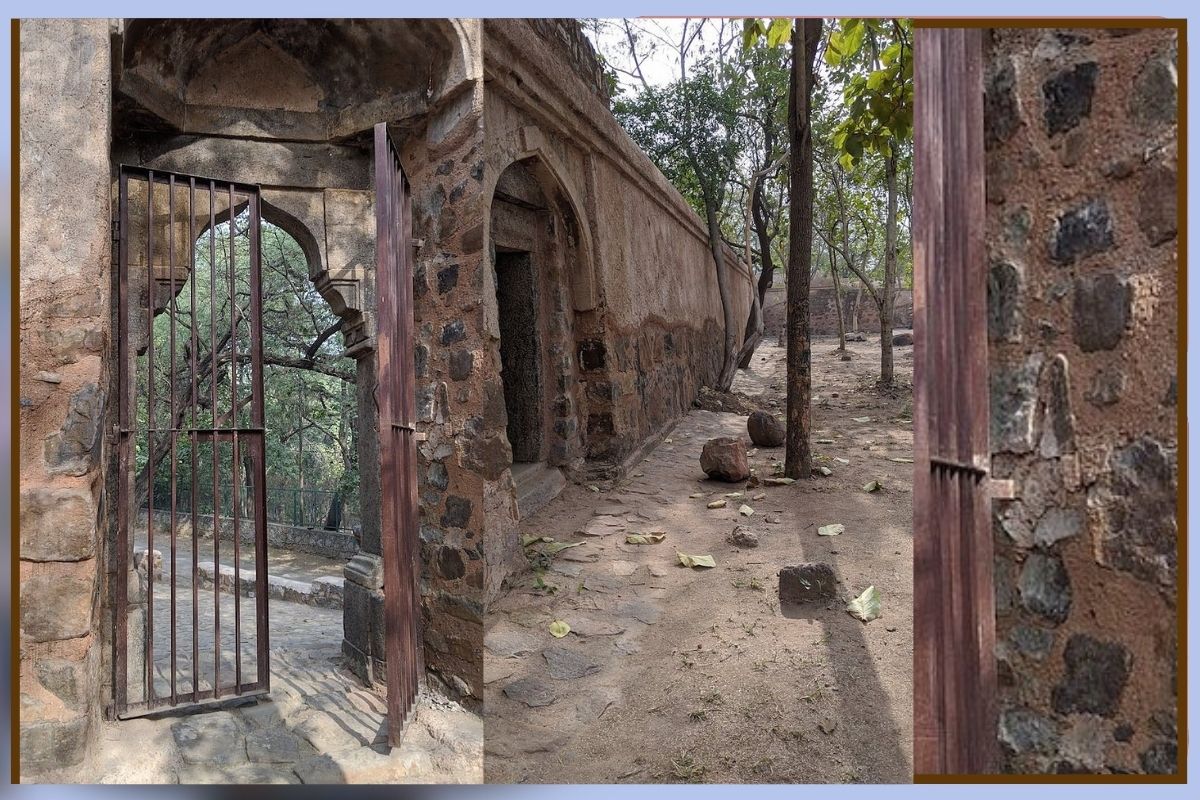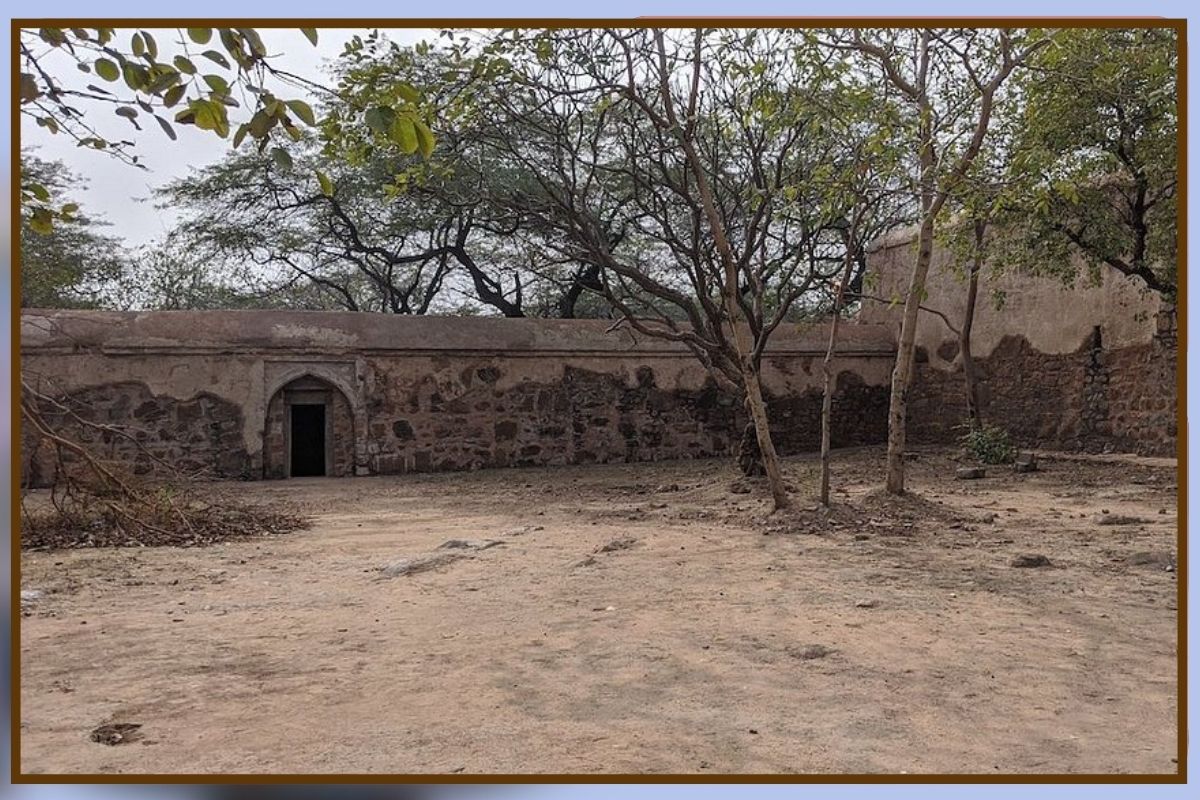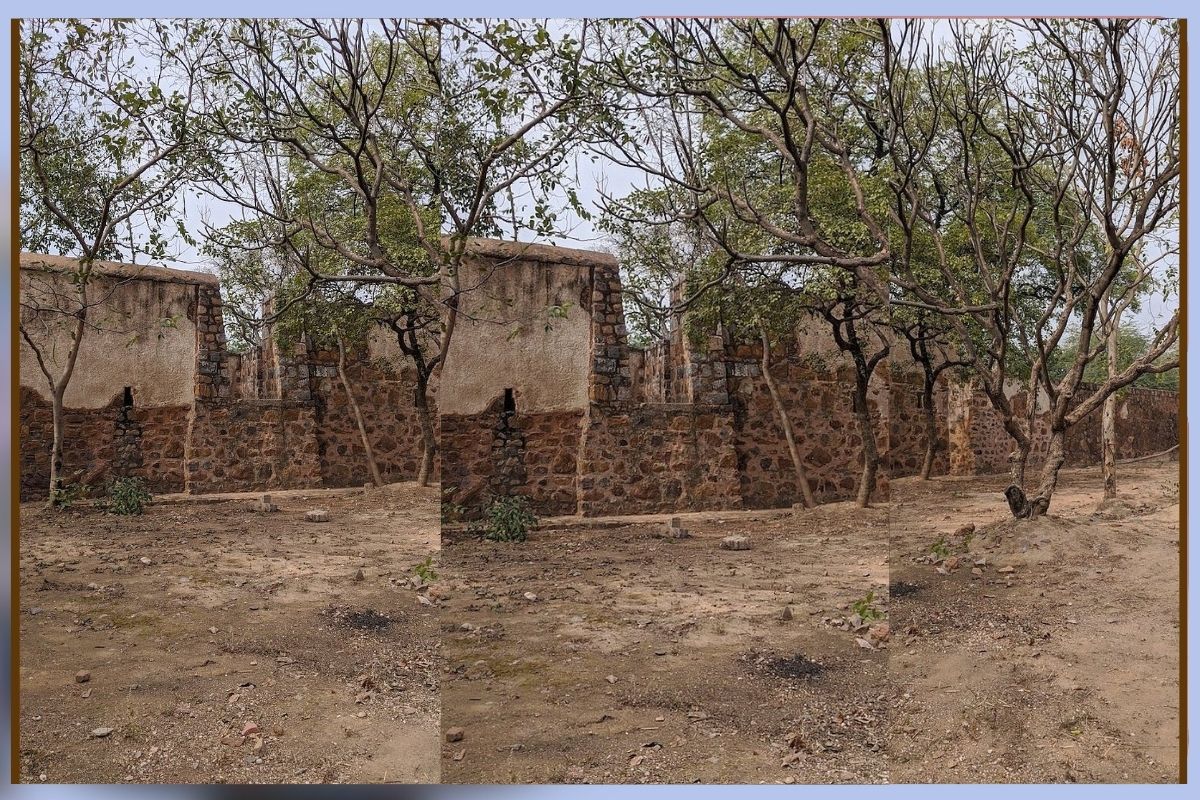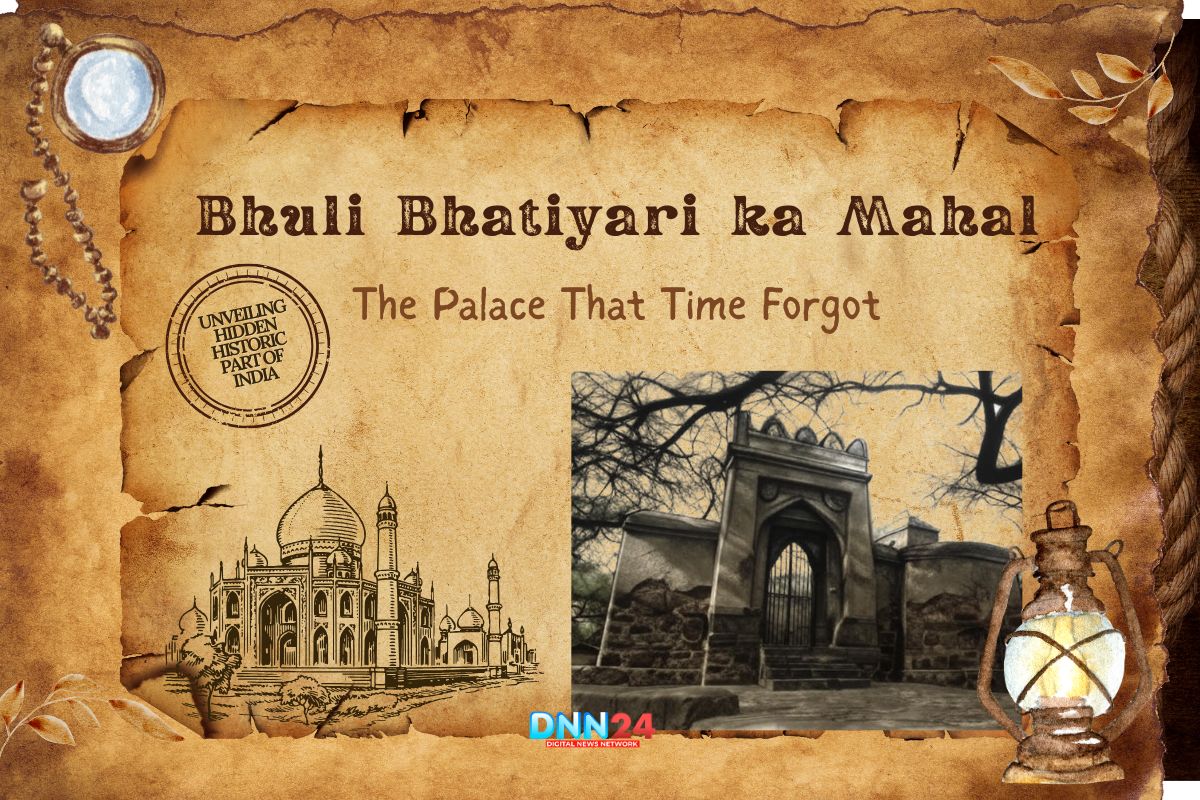Deep within Delhi’s Central Ridge, where the city’s chaos surrenders to ancient silence, stands a monument that refuses to be categorised. Bhuli Bhatiyari ka Mahal isn’t just another historical site; it’s a riddle wrapped in stone, a ghost story told through architecture, and a testament to how the most captivating places often hide in plain sight.
When Sultans Hunted More Than Glory
The year was 1354. Sultan Firoz Shah Tughlaq, known for his ambitious building projects across the Delhi Sultanate, commissioned what would become one of the capital’s most enigmatic structures. But this wasn’t meant to be another grand palace or imposing fort. Instead, the Sultan envisioned something intimate yet functional, a hunting lodge that would serve as a royal retreat during his expeditions into the wild Ridge forests.

The choice of location was deliberate and brilliant. Tucked away in what is now the Central Ridge Reserve Forest near Jhandewalan, the lodge offered the perfect blend of accessibility and isolation. Here, away from the political intrigue and ceremonial demands of court life, the Sultan and his hunting parties could indulge in the medieval equivalent of glamping, complete with stone chambers, arched courtyards, and strategic vantage points for spotting game.
What makes this lodge architecturally fascinating is its twin-gated northeastern entrance, an unusual design feature that hints at both practicality and paranoia. The structure encompasses a large rectangular courtyard flanked by smaller chambers, likely used for storing hunting equipment, resting between expeditions, and housing the retinue of servants, guards, and hunting companions who accompanied royal excursions.
The building’s design philosophy reflected the Tughlaq dynasty’s characteristic blend of functionality and aesthetic sensibility. Unlike the ornate Mughal monuments that would later define Delhi’s architectural landscape, Bhuli Bhatiyari ka Mahal embraced a more austere beauty. Its Indo-Islamic arches, robust rubble masonry construction, and strategic positioning within the natural landscape demonstrated how medieval architects could create harmony between human ambition and environmental constraints.

But the most intriguing aspect of the lodge’s original purpose lies in what historians have recently uncovered: evidence suggests that during non-hunting seasons, the structure may have doubled as an inn for travellers and wayfarers. This practical transformation reveals the adaptive genius of medieval architecture, buildings designed not as static monuments to ego, but as living spaces that could evolve with changing needs.
The Woman Behind the Name
Every great mystery needs a compelling origin story, and Bhuli Bhatiyari ka Mahal delivers several. The monument’s name has sparked debates among historians, folklorists, and local storytellers for centuries, with each theory adding another layer to its mystique.
The most widely accepted explanation traces the name to a wandering woman, though exactly who she was depends on which version of the tale you encounter. Some accounts describe a tribal woman from Rajasthan who lost her way in the dense Ridge forests and took shelter in the abandoned lodge. Over time, she became its unofficial guardian, tending to the structure and offering guidance to lost travellers. Her presence became so integral to the site that locals began referring to it as her palace.

Another version introduces Bu-Ali Bhatti, a female caretaker who supposedly maintained the lodge during its declining years. This interpretation connects the monument to Delhi’s forgotten communities, the countless individuals whose stories never made it into official historical records but whose lives shaped the city’s cultural fabric.
The most spiritually charged theory links the name to a Sufi saint who sought solitude within these walls. In this telling, the lodge became a place of contemplation and prayer, where the boundaries between the physical and metaphysical worlds grew thin. This connection to Sufism adds a mystical dimension to the monument, suggesting that its reputation for supernatural occurrences might have deeper spiritual roots.

What’s particularly fascinating about these competing narratives is how they reflect different aspects of medieval Delhi’s social complexity. Whether the namesake was a tribal refugee, a working-class caretaker, or a religious mystic, each story acknowledges the role of marginalised voices in shaping the city’s heritage, voices that traditional historical accounts often overlook.
Architecture Meets Wilderness
The genius of Bhuli Bhatiyari ka Mahal lies not just in its individual design elements, but in how it functions as part of a larger ecological and architectural ecosystem. Firoz Shah Tughlaq’s decision to build hunting lodges throughout the Ridge wasn’t merely about creating convenient stopping points for royal expeditions; it was an early form of landscape architecture that recognised the intrinsic value of preserving green spaces within urban environments.
The lodge’s positioning demonstrates a sophisticated understanding of topography and climate. Built on elevated ground within the Ridge’s plateau-like terrain, it offers natural ventilation and protection from flooding while maintaining visual connections to the surrounding forest. The structure’s orientation maximises natural light during winter months while providing shade during Delhi’s brutal summers.

From an ecological perspective, these hunting lodges served an unexpectedly progressive function. By establishing royal claims to specific forest areas, they inadvertently protected large swaths of the Ridge from agricultural encroachment and urban development. The presence of these monuments created informal conservation zones centuries before the concept of environmental protection entered mainstream consciousness.
Today, visitors can observe how nature has reclaimed much of the structure without destroying it. Moss covers the ancient stones, wild vegetation grows through gaps in the masonry, and birds nest in the carved niches intended initially for oil lamps. This symbiosis between architecture and ecology creates an atmosphere unlike any other Delhi monument, one where history feels alive and continuously evolving.
Ghosts, Legends, and Modern Mysteries
No discussion of Bhuli Bhatiyari ka Mahal would be complete without addressing its reputation as one of Delhi’s most haunted locations. The monument’s eerie atmosphere isn’t just the product of its isolated setting and ruined condition; it stems from decades of reported supernatural encounters that have become woven into local folklore.

The most persistent legend involves the imprisonment of a Tughlaq queen within the lodge’s walls. According to this tale, the queen was confined here following a scandalous affair, and her remains were never properly found or buried. Visitors and residents report hearing unexplained sounds, crying, footsteps, and whispered conversations, particularly after sunset. Some claim to have experienced sudden temperature drops, unexplainable feelings of being watched, or glimpses of shadowy figures moving through the ruins.
These ghost stories have become so pervasive that local authorities actively discourage visitors from entering the site after dark. Whether one believes in supernatural phenomena or not, there’s no denying that Bhuli Bhatiyari ka Mahal possesses an atmosphere that can make even sceptical visitors feel unsettled.
From a psychological perspective, the monument’s haunted reputation might stem from its liminal nature, which exists at the intersection of urban and wild, ancient and contemporary, preserved and ruined. Such spaces often trigger deep-seated human responses to mystery and the unknown, making them fertile ground for ghost stories regardless of any actual paranormal activity.
Renaissance and Restoration
The 2025 restoration and landscaping initiatives represent a turning point in Bhuli Bhatiyari ka Mahal’s modern story. These efforts aim to transform the site from an intimidating, overgrown ruin into an accessible heritage destination that honours both its historical significance and ecological value.

The restoration philosophy emphasises sensitive intervention rather than heavy-handed reconstruction. Walkways and signage have been designed to guide visitors safely through the monument while preserving its mysterious atmosphere. Native flora has been reintroduced to support biodiversity while creating natural viewing areas and rest spots for visitors.
Perhaps most importantly, the restoration includes low-impact lighting systems that extend visiting hours into the early evening without compromising the site’s nocturnal wildlife or its legendary ambience. These improvements open new possibilities for cultural programming, educational activities, and community engagement.
A Living Monument
Today, Bhuli Bhatiyari ka Mahal stands as proof that Delhi’s most compelling stories often unfold in its quieter corners. Unlike the city’s famous monuments that command attention through sheer scale and grandeur, this humble hunting lodge draws visitors through subtlety, mystery, and the promise of personal discovery.

For urban explorers, it offers a rare opportunity to experience Delhi’s medieval past without crowds or commercial tourism infrastructure. For nature lovers, it provides a unique setting where architecture and ecology coexist in fascinating harmony. For those intrigued by the paranormal, it delivers an authentically eerie atmosphere steeped in genuine folklore rather than manufactured scares.
Most importantly, Bhuli Bhatiyari ka Mahal reminds us that heritage isn’t just about preserving buildings; it’s about maintaining spaces where imagination can flourish, where multiple narratives can coexist, and where the past remains actively engaged with the present. In a city racing toward an uncertain future, this forgotten palace offers something increasingly rare: an invitation to slow down, pay attention, and rediscover the magic hiding in plain sight.
Also Read: Chor Minar: Delhi’s Tower of Terror and Time
You can connect with DNN24 on Facebook, Twitter, and Instagram and subscribe to our YouTube channel.

